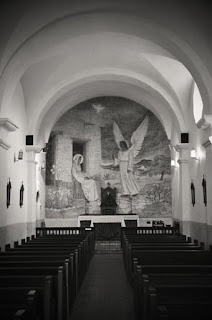 |
| The Presidio in Goliad |
After fending off four separate attacks on the first day, the Texans spent that night digging trenches. In the morning, however, they found they were now totally surrounded by the enemy. Almost out of ammunition, Fannin asked for a parley to prevent his troops from being massacred. General Urrea, commander of the Mexican forces, promised the Texans would be treated as prisoners of war and given clemency.
Upon surrender, the Texans were marched back to the Presidio at Goliad and placed under the watchful eyes of Nicolas de la Portilla and his detachment of men while Urrea and his remaining troops continued their march south. However, Santa Anna, the president of Mexico, was determined to fight a war of extermination and ordered Portilla to execute the prisoners. Having conflicting orders from General Urrea and General Santa Anna, Portilla chose to follow Santa Anna's orders.
 |
| Inside the walls of the Presidio where the wounded were killed |
Back at the presidio, the Mexicans stood the wounded against the chapel wall and executed them. The wounded who couldn't stand were shot in their beds. Fannin, who had been shot in the thigh during the original engagement, was the last to be killed. His three dying wishes were to be shot in the chest, given a Christian burial, and have his watch sent to his family. Instead, Portilla shot Fannin in the face, burned his body with the others, and kept the timepiece as a war prize. In all, nearly 350 men were killed at Goliad.
Today, almost 185 years later, the old presidio and its adjacent Chapel of our Lady of Loreto still stand. Given the horrific events that happened within and around the site, is it any wonder the walls sometimes echo with the mournful sounds of spirits returning from that troubled and turbulent time?
Visitors often report feeling "cold spots" and uneasy feelings as they walk around the grounds where Fannin and his men were executed. In 1992, a man named Jim reported strange goings-on. As a former deputy sheriff and a security guard for a number of years, Jim was not a man easily frightened or prone to make up wild stories. Hired for a few nights to watch over some equipment at the presidio that was to be used for the Cattle Baron's Ball, he expected quiet routine nights. On his first night though, just before midnight, the silence was broken by the "eerie, shrill cries of nearly a dozen terrified infants." He swore the sounds indicated "pain and suffering." Although understandably frightened, he tried to find where the sounds were coming from. After several long minutes, he finally determined they were coming from one of the dozen or so unmarked graves that are located near the Chapel of Our Lady of Loreto.
As he shined his flashlight on the spot, the cries abruptly stopped but were immediately replaced by the singing of a women's choir. It sounded like it was coming from the back wall of the old fort, but the beam of his flashlight revealed nothing there. After two or three minutes, the singing stopped and silence returned for the rest of the night. When Jim reported his experience, he was teased by his co-workers, but he is convinced what he saw and heard was real and besides, he is not the only person to report strange things in and around the presidio.
 |
| The chapel |
A woman in a white dress has been reported kneeling and crying by the graves of the children. When seen, she then turns and looks directly at the person before gliding over to a wall and vanishing. A beautiful soprano voice is often heard emanating from one particular room, but upon investigation, there is nobody in the small space. Visitors who stay late often come back from the fort and comment to the staff about the historical reenactors even though there are no reenactors on the property that day.
It seems there are many restless spirits here. Who are the crying babies? Are they the little lost souls of pioneer infants killed by Indians in a raid or was there an epidemic that took their too-short lives. The woman in white - is her own child buried in one of the unmarked graves? Why does the short friar keep returning? Is his soul in turmoil over so many brave men who were brutally executed? Whose souls are eternally singing beautiful hymns in a choir, unable to leave this chapel? Caught in a timeless web, so many lost souls searching, sorrowing, singing, praying, unable to let go of the life they briefly lived in a little town named Goliad.





